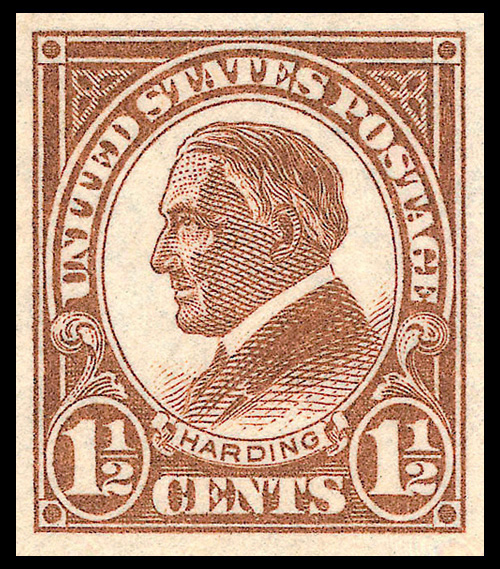Basic Info
1¢ - Green, deep green
Printing Method: FLAT PLATE
Subject: Benjamin Franklin
Number issued: 16,072,400
Perforations: Imperf
Watermark: Unwatermarked
Scott #: 575
Issued: March 20th, 1923
Value
Used
$2 - $3
No postmark with gum (MH)
$1 - $2
Full perfect gum, no postmark
no trace of stamp hinge mark (MNH)
$2 - $5
Plate #'s

#575 was issued with the following plate #'s
Number only
14157-60
14245
15045
15106-46
15331-44, 66, 72, 98, 99
15964-91
16043-50, 61-62
16400-32, 56, 89-90
16656-61, 68-69
Why imperforate?

There still being one manufacturer who used coils privately perforated this stamp was issued in four hundred subject sheets. It was also on sale at the Philatelic Agency and collectors had easy access to copies. However, the introduction of the 3,000 subject coils having made their further issuance unnecessary this practice was discontinued late in 1927. Most collectors and dealers believing the supply at the Bureau would long remain available failed to make the most of the opportunity and did not obtain sufficient copies to fill their needs. This variety is therefore more desirable than the perforated copies though more plentiful than the one cent imperforate stamp.
Because of the easy availability of mint copies from the Philatelic Agency almost all copies that survive today are unused. Blocks with cancels are scarce as the manufacturer had ordered them from the bureau for use as coils. Blocks would have been used on philatelic covers
Guide Lines


Each pane of 100 on a sheet of 400 stamps were separated by guide lines. Seen above are two examples. The first one illustrates the guideline at the margin of the sheet, there being four of these on a sheet. The second one illustrates the crossing of the guidelines at the center of the sheet, there being only one example in each sheet. They sell for $7 and $25 respectively.
Schermack Type III Perforations


If an ordinary 10 perforation stamp were to be taken from a stamp vending machine by a customer it is highly likely it would tear. That would leave the customer with half a stamp in their hand and the other half sticking out of the machine. In order to solve this problem the makers of vending machines purchased coils of stamps without perforations and, under licence, perforated them themselves. Various perforations were tried, some with large holes, some with a few small holes, and some with rectangles.
The type III perforation shown here was one of the most successful in preventing the stamp tearing, it was also the most widely used.

A change of name
The Schermack Type III perforations were developed by the Schermack Mailing Machine Company before it became the Mailometer Company by acquisition. The Type III pattern was used in the Mailometer affixing machines from 1908 through 1927.
The name of the company went through several changes, from the original "Detroit Mailing Machine Company", to the "Schermack Mailing Machine Company", and after Schermack resigned to the "Mail-om-eter Company" and finally to the "Mail-O-Meter Company" or simply "Mailometer Company".
Fake Schermacks

Many genuine issues produced with Schermack Type III perforations also have their fake counterparts. Under strong magnification examine the rectangular holes of a genuine Schermack perforation. Compare them carefully with the item in question. Fakes often show a very sharp, cleanly cut edge that is not indicative of the genuine






















